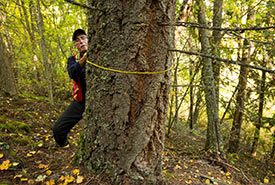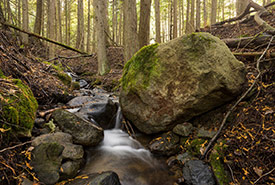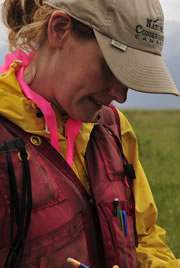A walk in the woods: Columbia forest region

Measuring trees on the Midgeley Conservation Area (Photo by Steve Ogle)
To walk through the forests of the Columbia forest region is, to me, a huge privilege. This is for two reasons: one, the Columbia forest region is home to home a number of Nature Conservancy of Canada (NCC) properties, including NCC’s largest conservation area, Darkwoods, and the neighbouring Midgeley Conservation Area. And two, these forests can be as ancient and wet as the better-known rainforests on our west coast.
I live in the forest region over, in the much drier montane forest region, where generally forests are dominated by two, maybe three, species and are much younger due to a frequent fire cycle. Walking through the forests of the Columbia region is a real treat for me, as it offers something new at every turn, from maple leaves crunching underfoot, to discovering massive white pine cones, to towering red cedar trees. For a biologist, it is similar to a scavenger hunt.
The Columbia forest region is known for its western red cedar and western hemlock forests. Think of it as the drier cousin of BC’s iconic coastal temperate rainforests. Although overall precipitation in this region is lower than on the coast. The greater snow melt in the summer supplies forests with the moisture they require. These forests are actually known as interior rain forests, and sometimes even called “snow forests.” This unique combination of year-round moisture and warm, interior summers has allowed this region to develop the highest tree species diversity in the province.
In the wetter parts of the zone, where fires are infrequent, ancient forests predominate. Here, trees grow to great sizes (12–15 metre circumference) and ages, rivalling the giant trees on the British Columbia coast. In the drier areas, where fire is a common disturbance, thick-barked Douglas-fir and ponderosa pine dominate, and multiple species at risk are found, including: western skinks, Coeur d’Alene salamander and western screech owl.

Cedar forests on the Midgeley property (Photo by Steve Ogle)
The 160-acre (65-hectare) Midgeley Conservation Area exemplifies the forests of the Columbia region. Walking around Midgeley will take you past 13 different tree species and through the dry and wet forests of the Columbia forest region. Not only that, you will also likely be walking in the footsteps of grizzly bears travelling between the Selkirk and Purcell Mountains. Midgeley is frequently used by grizzly bears travelling between the forests of the Selkirk and Purcell Mountains.
The Columbia forest region is a biologically diverse region that is home to many tree species and a host of wildlife. If you get the chance to wander in these forests, take a moment to appreciate the diversity in the tree canopy overhead and don’t forget to keep your eyes open for the wildlife that lives here.


